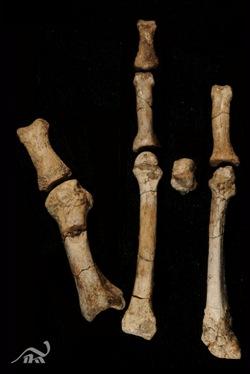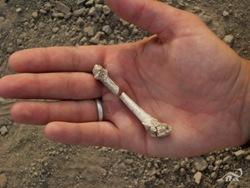'Lucy' lived among close cousins: Discovery of foot fossil confirms two human ancestor species co-existed
Cleveland Museum of Natural History
Source - http://www.physorg.com/news/2012-03-lucy-cousins-discovery-foot-fossil.html
 A team of scientists has announced the discovery of a 3.4 million-year-old partial foot from the Woranso-Mille area of the Afar region of Ethiopia. The fossil foot did not belong to a member of "Lucy's" species, Australopithecus afarensis, the famous early human ancestor. Research on this new specimen indicates that more than one species of early human ancestor existed between 3 and 4 million years ago with different methods of locomotion. The analysis will be published in the March 29, 2012 issue of the journal Nature.
A team of scientists has announced the discovery of a 3.4 million-year-old partial foot from the Woranso-Mille area of the Afar region of Ethiopia. The fossil foot did not belong to a member of "Lucy's" species, Australopithecus afarensis, the famous early human ancestor. Research on this new specimen indicates that more than one species of early human ancestor existed between 3 and 4 million years ago with different methods of locomotion. The analysis will be published in the March 29, 2012 issue of the journal Nature.
VIDEO = http://www.youtube.com/watch?v=mZ6v5ilOqec
The partial foot was found in February 2009 in an area locally known as Burtele.

"The Burtele partial foot clearly shows that at 3.4 million years ago, Lucy's species, which walked upright on two legs, was not the only hominin species living in this region of Ethiopia," said lead author and project leader Dr. Yohannes Haile-Selassie, curator of physical anthropology at The Cleveland Museum of Natural History. "Her species co-existed with close relatives who were more adept at climbing trees, like 'Ardi's' species, Ardipithecus ramidus, which lived 4.4 million years ago."
The partial foot is the first evidence for the presence of at least two pre-human species with different modes of locomotion contemporaneously living in eastern Africa around 3.4 million years ago. While the big toe of the foot in Lucy's species was aligned with the other four toes for human-like bipedal walking, the Burtele foot has an opposable big toe like the earlier Ardi.
"This discovery was quite shocking," said co-author and project co-leader Dr. Bruce Latimer of Case Western Reserve University. "These fossil elements represent bones we've never seen before. While the grasping big toe could move from side to side, there was no expansion on top of the joint that would allow for expanded range of movement required for pushing off the ground for upright walking. This individual would have likely had a somewhat awkward gait when on the ground."
The partial foot has not yet been assigned to a species due to the lack of associated skull and dental elements.
"Argon-argon radioactive dating showed the fossils were in a sandstone layer younger than about 3.46 million years old," said co- author Dr. Beverly Saylor of Case Western Reserve University. "Nearby fossils of fish, crocodiles and turtles, and physical and chemical characteristics of sediments show the environment was a mosaic of river and delta channels adjacent to an open woodland of trees and bushes," said Saylor. "This fits with the fossil, which strongly suggests a hominin adapted to living in trees, at the same time 'Lucy' was living on land."
UN PIED INCONNU BOUSCULE L'EVOLUTION HUMAINE
Source - http://www.lepoint.fr/science/un-pied-inconnu-bouscule-l-evolution-humaine-30-03-2012-1446607_25.php
Des chercheurs ont découvert un surprenant fossile qui suggère que Lucy a partagé son territoire avec un autre ancêtre.
C'est une nouvelle pièce du puzzle de l'évolution de l'homme que viennent de débusquer des chercheurs du Muséum d'histoire naturelle de Cleveland aux États-Unis. Un fossile partiel de pied découvert en février 2009 près de la localité de Burtele en Éthiopie semble appartenir à un hominidé encore inconnu. Un de plus, direz-vous... Mais ce n'est pas tout ! En datant ces ossements, les scientifiques ont constaté que l'individu étrange auquel appartenait le pied, nom de code BRT-VP-2/73, avait vécu il y a environ 3,4 millions d'années, dans cette région des Afars, en même temps que la célèbre représentante des Australopithecus afarensis,Lucy.
Si ces cousins-là se sont croisés, il y a fort à parier qu'ils se sont observés avec un certain étonnement... Alors qu'Australopithecus afarensis était déjà campée sur ses deux pieds munis de cinq orteils, BRT-VP-2/73, lui, possédait encore des pouces en guise de gros orteils, lui permettant de saisir les branches des arbres pour mieux y grimper, comme les grands singes d'aujourd'hui. Or, jusqu'ici, le dernier hominidé arboricole découvert, Ardipithecus ramidus, datait de 4,4 millions d'années. Cette découverte suggère donc que nos ancêtres ont continué de vivre dans les arbres bien plus longtemps que ce que l'on pensait.
Pour autant, les chercheurs, qui ont rendu compte de leurs travaux dans la revue Nature, pensent que le nouveau venu était également capable de se déplacer en se tenant debout sur ses jambes. C'est du moins ce que suggèrent la morphologie de son pied et, surtout, la forme singulière de ses articulations. Cela dit, cet hominidé devait être plus habile dans les branches que sur le sol, et sa démarche bien moins gracieuse que celle de Lucy.
Pour l'heure, difficile d'en dire plus, car, sans crâne ni dent, l'identité de ce nouvel ancêtre – ni Australopithecus afarensis, ni Ardipithecus ramidus - ne pourra pas être clairement établie. Il nous en dit toutefois un peu plus sur la manière dont la bipédie s'est finalement imposée. Sans doute plus progressivement que ce que l'on avait imaginé...